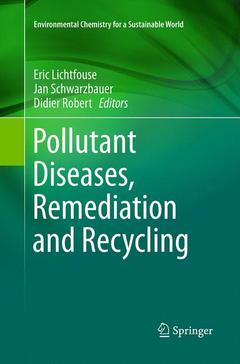Description
Pollutant Diseases, Remediation and Recycling, Softcover reprint of the original 1st ed. 2013
Environmental Chemistry for a Sustainable World Series, Vol. 4
Coordinators: Lichtfouse Eric, Schwarzbauer Jan, Robert Didier
Language: English
Subjects for Pollutant Diseases, Remediation and Recycling:
Publication date: 08-2016
Support: Print on demand
Publication date: 02-2014
545 p. · 15.5x23.5 cm · Hardback
Description
/li>Contents
/li>Biography
/li>Comment
/li>
Features chapters on artificial toxic substances in the environment
In particular includes readings on indoor air pollution and health related issues
Looks at pollutants from industrial wastewater from, amongst others, textile and petrochemical plants
Explains how fly ash can be recycled in for instance agriculture and includes techniques to remediate carcinogenic nitrosamines
Includes supplementary material: sn.pub/extras




